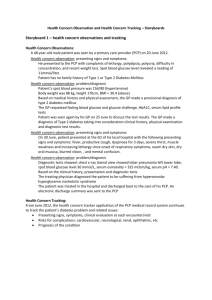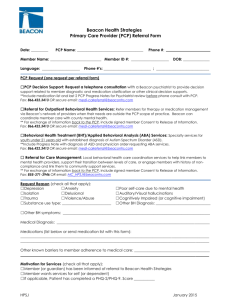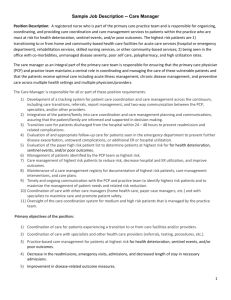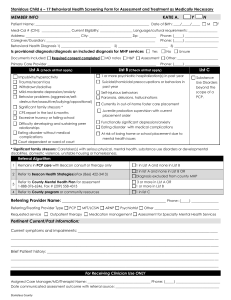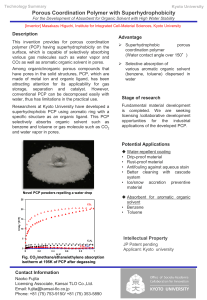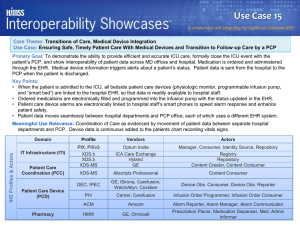Pentachlorophenol - Safe Work Australia
advertisement
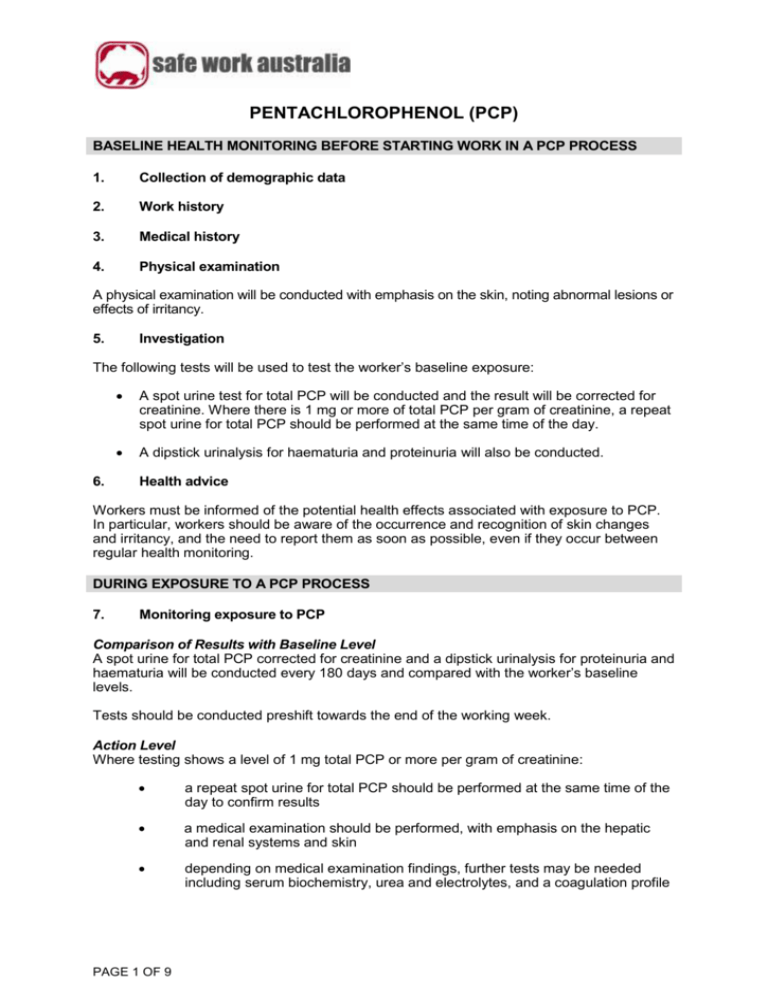
PENTACHLOROPHENOL (PCP) BASELINE HEALTH MONITORING BEFORE STARTING WORK IN A PCP PROCESS 1. Collection of demographic data 2. Work history 3. Medical history 4. Physical examination A physical examination will be conducted with emphasis on the skin, noting abnormal lesions or effects of irritancy. 5. Investigation The following tests will be used to test the worker’s baseline exposure: 6. A spot urine test for total PCP will be conducted and the result will be corrected for creatinine. Where there is 1 mg or more of total PCP per gram of creatinine, a repeat spot urine for total PCP should be performed at the same time of the day. A dipstick urinalysis for haematuria and proteinuria will also be conducted. Health advice Workers must be informed of the potential health effects associated with exposure to PCP. In particular, workers should be aware of the occurrence and recognition of skin changes and irritancy, and the need to report them as soon as possible, even if they occur between regular health monitoring. DURING EXPOSURE TO A PCP PROCESS 7. Monitoring exposure to PCP Comparison of Results with Baseline Level A spot urine for total PCP corrected for creatinine and a dipstick urinalysis for proteinuria and haematuria will be conducted every 180 days and compared with the worker’s baseline levels. Tests should be conducted preshift towards the end of the working week. Action Level Where testing shows a level of 1 mg total PCP or more per gram of creatinine: a repeat spot urine for total PCP should be performed at the same time of the day to confirm results a medical examination should be performed, with emphasis on the hepatic and renal systems and skin depending on medical examination findings, further tests may be needed including serum biochemistry, urea and electrolytes, and a coagulation profile PAGE 1 OF 9 the person conducting a business or undertaking must review control measures and carry out recommended remedial action the worker must be informed of the results of the health monitoring. Removal Level Removal from PCP work should be considered if there is evidence of adverse health effects due to PCP. A spot urine for total PCP corrected for creatinine should be repeated every 30 days until the level falls below 1 mg per gram of creatinine. Return to Work The worker must not return to PCP work until they have been assessed as medically fit to return to work by the medical practitioner supervising the health monitoring. AT TERMINATION OF WORK IN A PCP PROCESS 8. Final medical examination A final medical examination will be conducted with emphasis on the skin, noting abnormal lesions or effects of irritancy. SUPPLEMENTARY INFORMATION ON PCP 9. Work activities that may represent a high risk exposure PCP was once used as a preservative against timber-destroying fungi, sapstain moulds and some timber-boring insects and termites. Chloro-dibenzodioxins and dibenzofurans are known contaminants of PCP. Pentachlorophenol (PCP) is not currently approved for use as an agricultural or veterinary chemical in Australia. Examples of work activities involving PCP which require special attention when assessing exposure include: 10. workers who handle or breathe air near wood that has been preserved with PCP. Non-work sources PCP is found in all environmental media as a result of its past widespread use and can be detected in the urine and plasma of most non-work exposed people. Pentachlorophenol has been detected in fruits, vegetables, meats, water and soils. Small amounts of pentachlorophenol of up to 40 µg/L in urine may be found in the general population. POTENTIAL HEALTH EFFECTS FOLLOWING EXPOSURE TO PCP 11. Route of entry into the body The routes of PCP entry into the body are through inhalation and percutaneous absorption. Accidental ingestion is unlikely unless poor hygiene and work practices allow it. 12. Target organ/effect Skin, mucous membranes – irritation. Eyes – visual damage and irritation. Kidneys – impaired renal function. Liver – hepatocellular damage. PAGE 2 OF 9 13. Acute effects Acute toxicity results from the uncoupling of oxidative phosphorylation causing stimulation of cell metabolism and accompanying heat dissipation. Acute poisoning can affect both renal and hepatic function with elevations of alkaline phosphatase, serum creatinine and blood urea nitrogen. The most important effect of PCP inhalation is acute poisoning centring on the circulatory system. Physiological injury is mainly muscular with heart failure. Irritation of the eyes, mucous membranes and upper respiratory tract has been reported at airborne dust or mist concentrations of 1.0 mg/m3. Airborne concentrations as low as 0.3 mg/m3 may cause some irritation of the upper respiratory tract. Direct skin contact can lead to skin irritation and systemic toxicity. A 10 per cent solution may cause irritation after a single brief exposure, whereas prolonged or repeated contact with a one per cent solution would be required to produce the same result. A solution of 0.1 per cent concentration may lead to adverse systemic effects. Systemic effects from acute PCP poisoning include weakness, loss of appetite, gastrointestinal disturbance, weight loss, nausea, vomiting, chest pain, excessive sweating, fever, headaches and dizziness, inflammation of the conjunctiva, corneal opacity, tachycardia, tachypnoea, respiratory distress and hepatic enlargement. In fatal cases, the temperature is often very high and death may occur as early as three hours after the onset of symptoms. The risk of serious consequences is greater in hot weather. People with significantly impaired liver or kidney function are possibly more susceptible to poisoning from this substance. 14. Chronic effects Chronic exposure is associated with inflammation of the upper respiratory tract and bronchitis, blood effects like aplastic anaemia, effects on the kidney and liver, immunological effects, irritation of the eyes, nose and skin, increased prevalence of conjunctivitis, chronic sinusitis, polyneuritis and dermatitis. Bronchitis has been reported at airborne dust or mist concentrations of 1.0 mg/m3. Repeated exposure to PCP may cause an acne-like rash and liver and kidney damage. Deaths have occurred among workers involved in crop and herbicidal spray operations where a 1.5 to two per cent PCP solution was used without adequate control measures. In the body, PCP acts to uncouple oxidative phosphorylation, resulting in hyperthermia. Medications that cause dehydration, or possess anticholinergic properties, and diuretics, phenothiazines, antihistamines and antidepressants may also increase the susceptibility of exposed people to hyperthermia. Aspirin, which can also uncouple oxidative phosphorylation when absorbed in large amounts, may enhance the risk of toxicity for PCP-exposed people. Because PCP is highly proteinbound, people taking medications on a long-term basis that have an affinity for plasma proteins may be at increased risk of PCP-induced toxicity. Phenytoin, warfarin, furosemide, ethacrynic acid, naproxen and ibuprofen can compete with PCP for protein binding sites, increasing the level of free PCP circulating in the blood. PAGE 3 OF 9 15. Carcinogen classification1 Pentachlorophenol is classified according to the GHS as Carcinogenicity Category 2 (Suspected of causing cancer). FURTHER READING Agency for Toxic Substances and Disease Registry, Toxicological Profile for Pentachlorophenol, Agency for Toxic Substances and Disease Registry, United States Department of Health and Human Services, Public Health Service, Atlanta, 2001. American Conference of Governmental Industrial Hygienists (ACGIH ), Documentation of the Threshold Limit Values and Biological Exposure Indices, Pentachlorophenol, 7th Ed, Cincinnati, 2011. 1 This classification information is provided on an advisory basis and is taken from the European Union’s Annex VI to Regulation (EC) No 1272/2008, updated by the 1st Adaption to Technical Progress to the Regulation. Other hazard classes and categories may apply – see http://esis.jrc.ec.europa.eu/index.php?PGM=cla. These classifications are legally binding within the European Union. PAGE 4 OF 9 Health Monitoring Report PENTACHLOROPHENOL (PCP) This health monitoring report is a confidential health record and must not be disclosed to another person except in accordance with the Work Health and Safety Regulations or with the consent of the worker. There are two sections. Complete both sections and all questions if applicable. Section 1 is to be forwarded to the PCBU who has engaged your services. A copy of laboratory report(s) must be attached > > > > Section 2 may contain confidential information which may not be relevant to the health monitoring program being carried out. This section should be retained by the medical practitioner. Information which is required to be given to the PCBU should be summarised in part 7 of section 1. SECTION 1 – THIS SECTION TO BE RETURNED TO THE PCBU 1. PERSON CONDUCTING A BUSINESS OR UNDERTAKING Company / Organisation name: Site address: Site Tel: Suburb: Site Fax: Postcode: Contact Name: 2. OTHER BUSINESSES OR UNDERTAKINGS ENGAGING THE WORKER Company / Organisation name: Site address: Site Tel: Suburb: Site Fax: Postcode: Contact Name: 3. WORKER () all relevant boxes Surname: Date of birth: DD/MM/YYYY Given names: Male Sex: Address: Current Job: Female Suburb: Postcode: Tel(H): Mob: Date started employment : DD/MM/YYYY 4. EMPLOYMENT IN PENTACHLOROPHENOL (PCP) RISK WORK 1. New to PCP work 2. New worker but not new to PCP work 3. Current worker continuing in PCP work 4. Worked with PCP since DD/MM/YYYY 5. Satisfactory personal hygiene (for example nail biting, frequency of hand washing) Yes No 6. Risk assessment completed Yes No PAGE 5 OF 9 () all relevant boxes Health Monitoring Report PENTACHLOROPHENOL (PCP) 5. WORK ENVIRONMENT ASSESSMENT () all relevant boxes Date of assessment: DD/MM/YYYY Pentachlorophenol Industry Timber Industry Controls: Other (specify): _________ Wear gloves Yes No Respirator use Yes No Local exhaust ventilation Yes No Overalls / work clothing Yes No Laundering by employer Yes No Wash basins & showers (with hot & cold water) Yes No Smoking or eating in workshop Yes No Clean Shaven Yes No Shower & change into clean clothes at end of shift Yes No Personal hygiene: 6. BIOLOGICAL MONITORING RESULTS Date Test Performed Include at least the previous two test results (if available) Recommended Action and/or Comment 1. DD/MM/YYYY 2. DD/MM/YYYY 3. DD/MM/YYYY 4. DD/MM/YYYY 5. DD/MM/YYYY 6. DD/MM/YYYY 7. DD/MM/YYYY 7. RECOMMENDATIONS (by Medical Practitioner) () all relevant boxes 1. Suitable for work with PCP 2. Counselling required 3. Review workplace controls 4. Repeat health assessment in ______ month(s) / ______ week(s) 5. Removal from work with PCP On DD/MM/YYYY 6. Medical examination by Medical Practitioner On DD/MM/YYYY 7. Fit to resume PCP risk work PAGE 6 OF 9 From DD/MM/YYYY Health Monitoring Report PENTACHLOROPHENOL (PCP) 8. Referred to Medical Specialist (respiratory/dermatology/other): Specialist’s name: On DD/MM/YYYY Additional comments or recommendations arising from health monitoring: Medical Practitioner (responsible for supervising health monitoring) Name: Tel: Date: DD/MM/YYYY Signature Fax: Registration Number: Medical Practice: Address: PAGE 7 OF 9 Suburb: Postcode: Health Monitoring Report PENTACHLOROPHENOL (PCP) SECTION 2 – THIS SECTION TO BE RETAINED BY THE MEDICAL PRACTITIONER 1. PERSON CONDUCTING A BUSINESS OR UNDERTAKING Company / Organisation name: Site address: Site Tel: Suburb: Site Fax: Postcode: Contact Name: 2. OTHER BUSINESSES OR UNDERTAKINGS ENGAGING THE WORKER Company / Organisation name: Site address: Site Tel: Suburb: Site Fax: Postcode: Contact Name: 3. WORKER () all relevant boxes Surname: Date of birth: DD/MM/YYYY Given names: Sex: Address: Male Suburb: Current Job: Tel(H): Female Pregnant/Breast Feeding? Postcode: Mob: Date started employment : DD/MM/YYYY 4. GENERAL HEALTH ASSESSMENT (if applicable) Symptoms of: Comments Further testing? Skin disorders Yes No Headaches, dizziness Yes No Respiratory tract Yes No Eyes Yes No Mucous membranes Yes No CNS Yes No Yes No Others Height _____cm Weight _____kg Bp ____/____ mmHg PAGE 8 OF 9 Health Monitoring Report PENTACHLOROPHENOL (PCP) 5. OTHER MEDICAL HISTORY, FAMILY MEDICAL HISTORY, CURRENT MEDICATION, COMMENTS, TESTS OR RECOMMENDATIONS (use separate sheet if necessary) Medical Practitioner (responsible for supervising health monitoring) Name: Tel: Date: DD/MM/YYYY Signature Fax: Registration Number: Medical Practice: Address: PAGE 9 OF 9 Suburb: Postcode:


